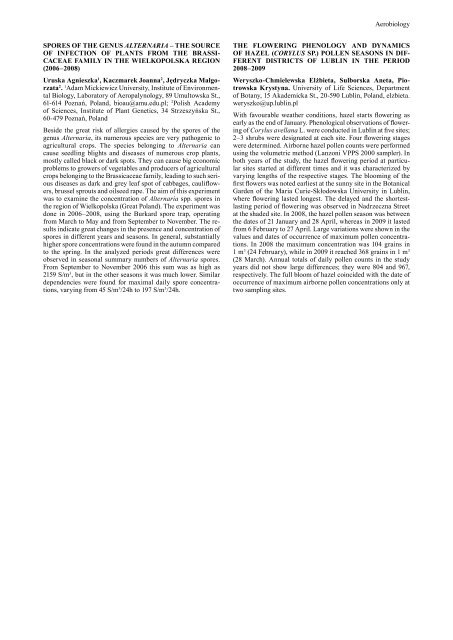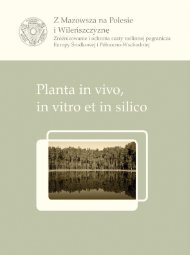acta societatis botanicorum poloniae - LV Zjazd Polskiego ...
acta societatis botanicorum poloniae - LV Zjazd Polskiego ...
acta societatis botanicorum poloniae - LV Zjazd Polskiego ...
You also want an ePaper? Increase the reach of your titles
YUMPU automatically turns print PDFs into web optimized ePapers that Google loves.
SPOrES OF THE GENUS AlternAriA – THE SOUrCE<br />
OF INFECTION OF PLANTS FrOM THE BrASSI-<br />
CACEAE FAMILY IN THE WIELKOPOLSKA rEGION<br />
(2006– 2008)<br />
Uruska Agnieszka 1 , Kaczmarek Joanna 2 , Jędryczka Małgorzata<br />
2 . 1 Adam Mickiewicz University, Institute of Environmental<br />
Biology, Laboratory of Aeropalynology, 89 Umultowska St.,<br />
61-614 Poznań, Poland, bioau@amu.edu.pl; 2 Polish Academy<br />
of Sciences, Institute of Plant Genetics, 34 Strzeszyńska St.,<br />
60-479 Poznań, Poland<br />
Beside the great risk of allergies caused by the spores of the<br />
genus Alternaria, its numerous species are very pathogenic to<br />
agricultural crops. The species belonging to Alternaria can<br />
cause seedling blights and diseases of numerous crop plants,<br />
mostly called black or dark spots. They can cause big economic<br />
problems to growers of vegetables and producers of agricultural<br />
crops belonging to the Brassicaceae family, leading to such serious<br />
diseases as dark and grey leaf spot of cabbages, cauliflowers,<br />
brussel sprouts and oilseed rape. The aim of this experiment<br />
was to examine the concentration of Alternaria spp. spores in<br />
the region of Wielkopolska (Great Poland). The experiment was<br />
done in 2006– 2008, using the Burkard spore trap, operating<br />
from March to May and from September to November. The results<br />
indicate great changes in the presence and concentration of<br />
spores in different years and seasons. In general, substantially<br />
higher spore concentrations were found in the autumn compared<br />
to the spring. In the analyzed periods great differences were<br />
observed in seasonal summary numbers of Alternaria spores.<br />
From September to November 2006 this sum was as high as<br />
2159 S/m 3 , but in the other seasons it was much lower. Similar<br />
dependencies were found for maximal daily spore concentrations,<br />
varying from 45 S/m 3 /24h to 197 S/m 3 /24h.<br />
Aerobiology<br />
THE FLOWErING PHENOLOGY ANd dYNAMICS<br />
OF HAZEL (corylus SP.) POLLEN SEASONS IN dIF-<br />
FErENT dISTrICTS OF LUBLIN IN THE PErIOd<br />
2008– 2009<br />
Weryszko-Chmielewska Elżbieta, Sulborska Aneta, Piotrowska<br />
Krystyna. University of Life Sciences, Department<br />
of Botany, 15 Akademicka St., 20-590 Lublin, Poland, elzbieta.<br />
weryszko@up.lublin.pl<br />
With favourable weather conditions, hazel starts flowering as<br />
early as the end of January. Phenological observations of flowering<br />
of Corylus avellana L. were conducted in Lublin at five sites;<br />
2– 3 shrubs were designated at each site. Four flowering stages<br />
were determined. Airborne hazel pollen counts were performed<br />
using the volumetric method (Lanzoni VPPS 2000 sampler). In<br />
both years of the study, the hazel flowering period at particular<br />
sites started at different times and it was characterized by<br />
varying lengths of the respective stages. The blooming of the<br />
first flowers was noted earliest at the sunny site in the Botanical<br />
Garden of the Maria Curie-Skłodowska University in Lublin,<br />
where flowering lasted longest. The delayed and the shortestlasting<br />
period of flowering was observed in Nadrzeczna Street<br />
at the shaded site. In 2008, the hazel pollen season was between<br />
the dates of 21 January and 28 April, whereas in 2009 it lasted<br />
from 6 February to 27 April. Large variations were shown in the<br />
values and dates of occurrence of maximum pollen concentrations.<br />
In 2008 the maximum concentration was 104 grains in<br />
1 m 3 (24 February), while in 2009 it reached 368 grains in 1 m 3<br />
(28 March). Annual totals of daily pollen counts in the study<br />
years did not show large differences; they were 804 and 967,<br />
respectively. The full bloom of hazel coincided with the date of<br />
occurrence of maximum airborne pollen concentrations only at<br />
two sampling sites.



